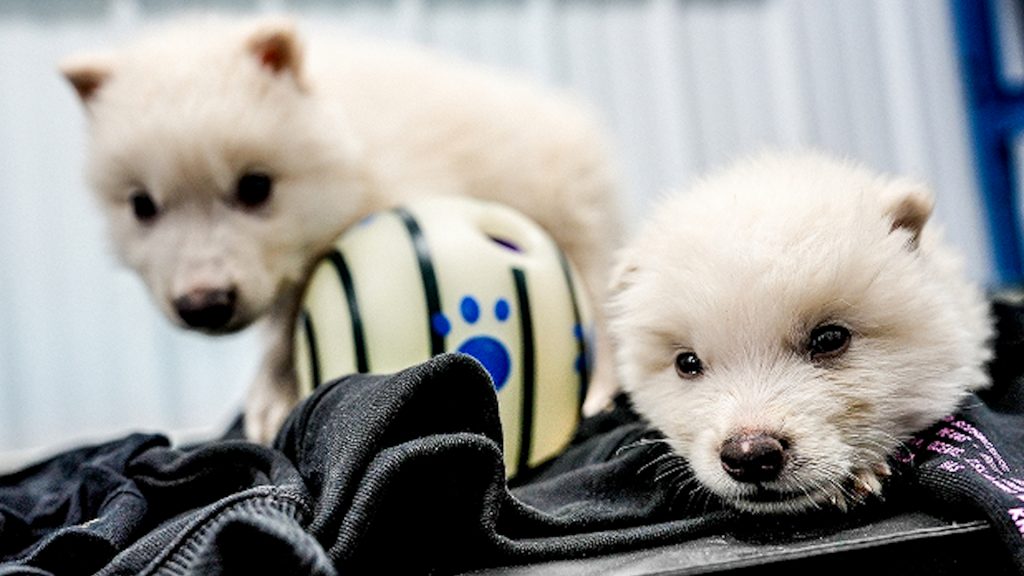Scientists revive dire wolves through gene editing after extinction
Ella Greene April 8, 2025 0
- Through genome editing and cloning, Colossal Biosciences produced three genetically engineered wolves resembling the long-extinct dire wolf. The company used ancient DNA to recreate 20 specific genetic traits.
- Scientists have observed key differences in the wolves, including broader heads and powerful jaws, which distinguish them from modern gray wolves.
- Colossal Biosciences is applying its de-extinction methods to conservation efforts, with ongoing projects to engineer woolly mammoths, dodos and thylacines.
Full Story
A U.S. biotech company successfully produced three genetically engineered wolves that resemble the long-extinct dire wolf.
The firm behind the effort, Colossal Biosciences, confirmed that the animals were created through genome editing and cloning based on ancient DNA.
The wolves — Romulus, Remus and Khaleesi — live at a private 2,000-acre preserve at an undisclosed location in the northern U.S.
Colossal Biosciences reported that Romulus and Remus are six months old and weigh around 80 pounds. The third, Khaleesi, is two months old.
When fully grown, the animals could reach 150 pounds — significantly larger than modern gray wolves.
How were dire wolf traits recreated?
To engineer the wolves, scientists analyzed DNA from two fossils: a 13,000-year-old tooth found in Ohio and a 72,000-year-old skull fragment from Idaho.
Using that information, they edited gray wolf cells to include 20 genetic traits resembling dire wolves — particularly size, musculature, coat color and jaw structure.
The modified cells were cloned and implanted into surrogate dogs, resulting in live births. One pup from the initial group died 10 days after birth due to intestinal infection.
Researchers said the wolves display key differences from modern gray wolves, including broader heads, thicker haunches and powerful jaws. Although the animals are not exact replicas — since dire wolves and gray wolves diverged genetically hundreds of thousands of years ago — Colossal Biosciences claimed the results meet its definition of “de-extinction.”
What is Colossal’s broader goal?
Founded in 2021, Colossal aims to bring back extinct species and apply its methods to conservation.
Alongside its work on dire wolves, the company continues efforts to engineer woolly mammoths, dodos and thylacines.
The startup has raised more than $435 million and recently announced a cloning breakthrough involving red wolves, a critically endangered American species.

Colossal Biosciences said its red wolf program could improve genetic diversity among the fewer than 20 wild red wolves remaining in the U.S.
The company developed a less invasive cloning method using blood-derived stem cells instead of tissue samples. These cloned red wolves come from three distinct lineages and could expand the species’ founding genetic base by 25%.
Will dire wolves return to the wild?
Colossal Biosciences said it has no current plans to rewild the dire wolves. Instead, researchers plan to monitor the animals’ lifespans to study gene expression, behavior and ecosystem potential.
However, tribal nations, including the Mandan, Hidatsa and Arikara, have expressed interest in eventually hosting the animals on tribal land.
Despite public fascination driven by pop culture portrayals of dire wolves, experts continue to debate whether the engineered animals qualify as de-extinct.
Genetically, they remain close to gray wolves. Some scientists suggested their ecological role, rather than the genome, may be more important in defining their identity.
What do scientists say about de-extinction?
Beth Shapiro, Colossal Biosciences’ chief science officer, said the project is a chance to rethink biodiversity loss.
“If we can look at this animal and see what it’s doing, and it looks like a dire wolf and acts like a dire wolf, I’m going to call it a dire wolf,” she told WIRED.

Shapiro previously coauthored a study reconstructing dire wolf evolutionary history and helped identify the genetic variants used in the company’s edits.
Ella Rae Greene, Editor In Chief
Ella Greene
Ella and the staff at Clear Media Project (CMP) curate these articles.
Unless otherwise noted CMP does not write these articles.
The views, thoughts, and opinions expressed in the articles published on this blog belong solely to the original authors and do not necessarily reflect the views of the blog owner. The blog owner does not claim ownership of the content shared by contributors and is not responsible for any inaccuracies, errors, or omissions.
All rights and credits goes to its rightful owners. No Copyright Infringement is intended. If you believe any content infringes on your rights, please contact us for review and potential removal.





